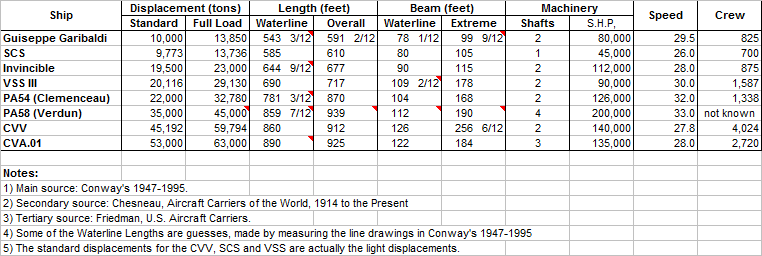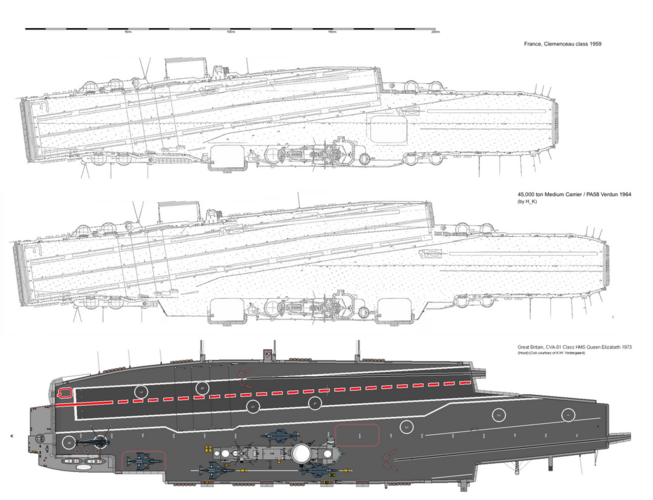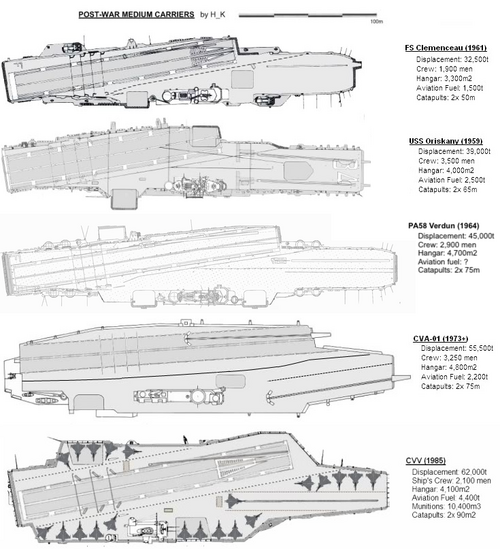... instead of re-inventing the wheel in the 70's.
The idea is to blend together, Zumwalt "cheaper decks" (SCS / VSS / CVV) and the too few carrier designs from Europe. To bolster NATO fleets on one side, and the USN on the other - more flattops on both sides of the Atlantic.
That is, adapting...
- Invincible-class for SCS (20 000 tons)
- Clemenceau / Verdun class for the VSS - VSTOL Support Ship (30 000 tons)
- CVA-01 for CVV (55 000 tons + )
With some serious VSTOL aircraft pornfest on the ships - CL-84 AEW, naval AH-56 Cheyenne, Harriers and Convair 200.
Thoughts?
Because the premise was to replace proposed US designs with European ones. PdA was derived the USN's (unbuilt) SCS design, the one Archibald proposed replacing with the British Invincible.
The whole thing makes little sense to me. The USN was never going to buy all of those designs. Getting any one of them would have been quite a point of departure. And adopting European designs just wasn't plausible. Everything from damage control to accommodations to propulsion would be different.
IMO the more interesting alternative is one where the USN buys one or two of these (possibly a smaller attack carrier and the SCS as an ASW escort carrier) and then aggressively subsidizes or promotes them to European navies.
Although
@TomS wasn't replying directly to
@Archibald he's more or less said what I wanted to say in reply to the Opening Post. Which is...
I think that the time and money required to modify those designs to suit the USN's requirements would have been the same as the time and money required to design the SCS, VSS and CVV in the first place.
For example Invincible instead of the SCS.
- Machinery. They'll have to redesign it around four LM2500 gas turbines instead of four Olympus gas turbines.
- Weapons. It will have Sea Sparrow or Standard MR instead of Sea Dart.
- Electronics and Sensors. This includes, but is not limited to, the Command, Control & Communications equipment, NTDS instead of ADAWS, American sonars instead of British sonars and American radars instead of British radars, e.g. SPS-48 instead of Type 1022.
And in the case of Clemenceau/Verdun in place of the VSS the USN would want gas turbines instead of steam turbines and the changes required to do that may well produce a ship closer to the VSS as designed than Clemenceau/Verdun.
In the case of CVA.01 instead of the CVV it is more likely that the USN would adapt the SCB.100 design. Although, by the time they'd finished adapting it SCB.100 might be the CVV as designed in the
"real world" in all but name.
I very much doubt that they'd be any quicker or cheaper to build. That's partially because I'm a believer in the theory that
"steel is cheap and air is free". The machinery (e.g. a LM2500 gas turbine), weapons (e.g. Standard MR), electronics (e.g. NTDS) and sensors (a SPS-48 radar) will cost the same whether they're fitted to a redesigned European hull or a bespoke American hull.
Building the designs
"off the shelf" i.e. with no changes to suit USN requirements and no American equipment instead of European equipment would produce non-standard ships which would cost more to operate.
Furthermore, it's all moot because Congress didn't let the USN buy any of the bespoke designs produced in the
"real world" and it won't let them buy any of the modified European designs
"in this version of history". If Congress was prepared to spend more money on the US Armed Forces
"in this version of history" the USN would spend its portion of the extra money on the
"real world" designs and to paraphrase the last sentence of the post by
@TomS the USN would aggressively subsidize or promote the American designs of the
"real world" to European navies.
However, if Congress was prepared to spend more money on the US Armed Forces in the 1970s I suspect that the USN would use its portion of the extra money to build as many extra Nimitz class as possible. Preferably, three so they could maintain a force of 15 carrier battle groups instead of the
"real world" reduction from 15 to 12.
By the way I appreciate that it's not just the cost of the extra aircraft carriers and their aircraft. It also the cost of the extra escorts, extra auxiliaries and extra shore facilities, e.g. expanding the training schools to train the extra crews. However, 3 CVBGs built around 3 CVVs would require them too. Plus I believe (but don't know) that the USN proved that a CVV wasn't significantly cheaper to build and operate than a Nimitz and that's why Congress rejected President Carter's request for a CVV and authorised Theodore Roosevelt in its place. I repeat that's what I believe, but don't know, because I haven't checked it, so please be gentle with me if that statement isn't 100% correct.
If there was any money left after that the USN would want to have enough 20-knot amphibious shipping to transport one MAF & one MAB and preferably two MAFs so 9 Tarawa class would be built instead of 5. And if any money was left after than buy enough SSNs to maintain a force of 100 instead of 90. Or vice versa, that is 100 SSNs first and then more amphibious ships.
To summarise the USN would expand (or more accurately not contract) to as close to the 600 Ship Navy as the extra money would allow.




